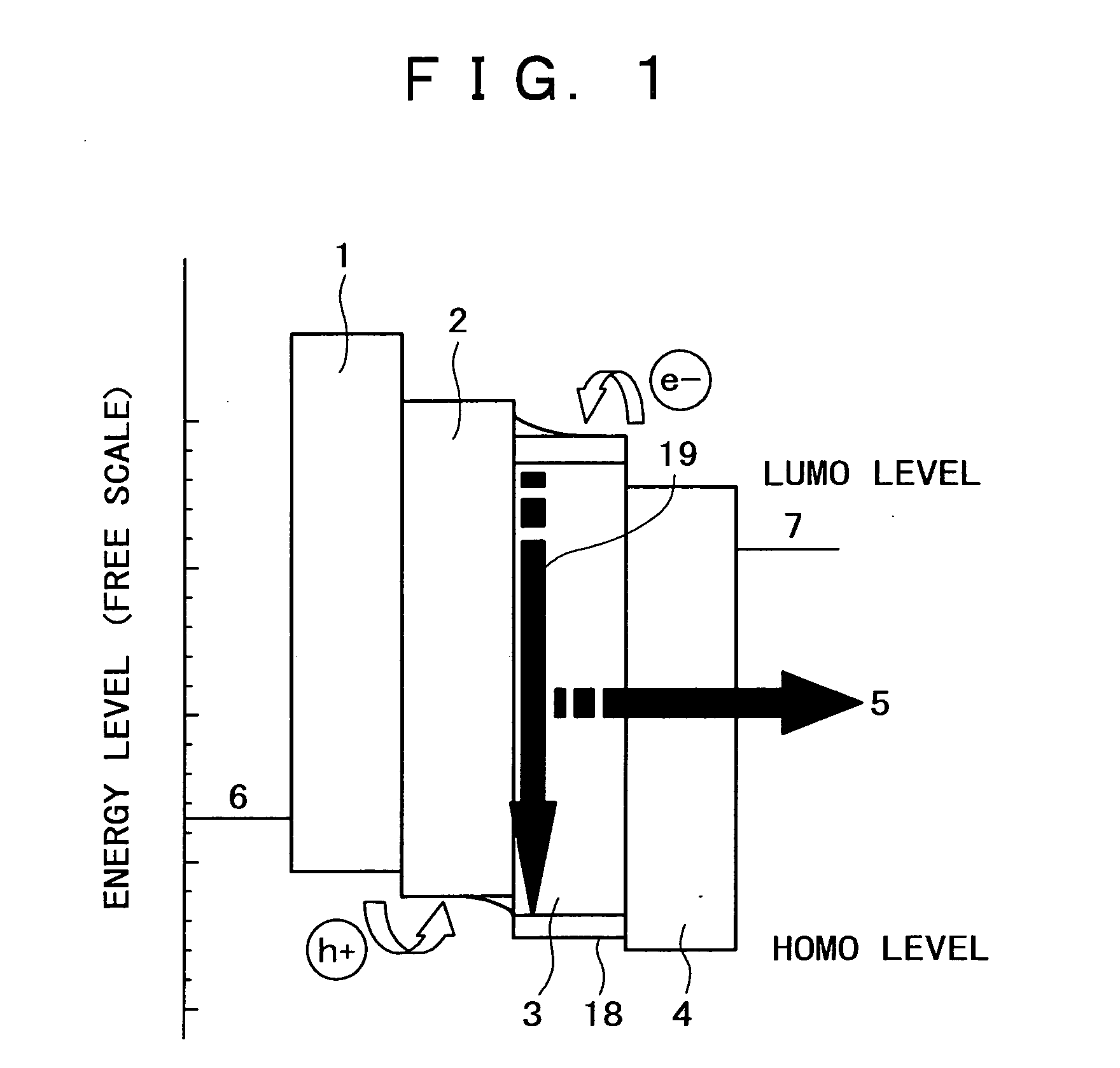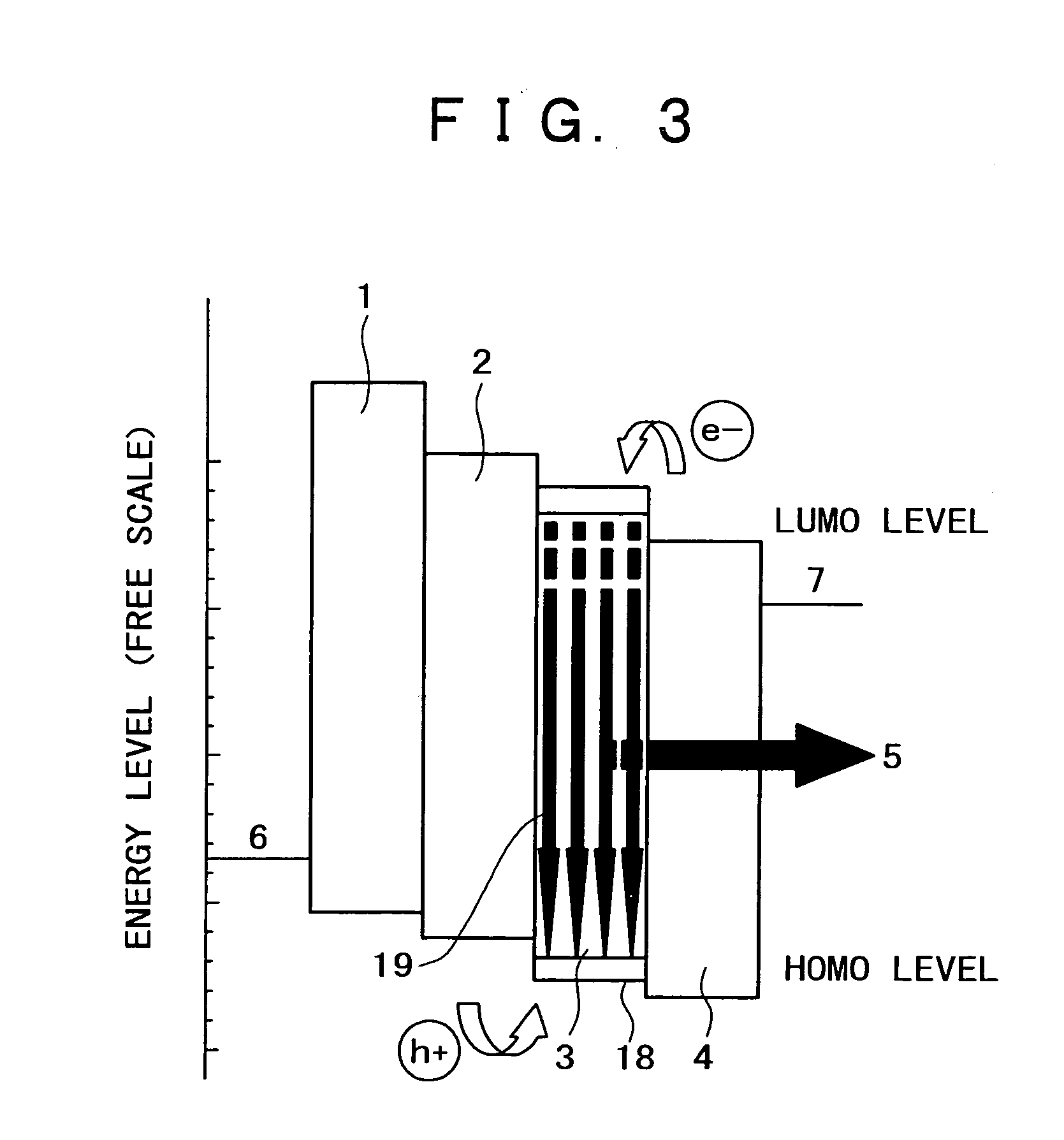Organic field emission device and emission device
a technology of emission device and organic field, which is applied in the direction of discharge tube/lamp details, luminescnet screen, discharge tube/lamp details, etc., to achieve the effect of improving the service life of the device and stable hu
- Summary
- Abstract
- Description
- Claims
- Application Information
AI Technical Summary
Benefits of technology
Problems solved by technology
Method used
Image
Examples
example 1
Concentration of Compound 1 and Luminous Efficiency
In this example, organic electroluminescence light emitting devices, each using, as a light emission layer having an electron transport characteristic, a mixed layer made from a styryl compound represented by a compound 1 described below and an electron transport material represented by Alq3 (tris (8-quinolinol) aluminum) described below, are produced as samples, and a relationship between a luminance of light emitted from each sample and a luminous efficiency of the sample is examined.
Samples of organic electroluminescence light emitting devices were prepared as follows: namely, as a light emission layer of each organic electroluminescence light emitting device, a mixed layer made from a styryl compound 1 expressed by the following chemical formula, and an electron transport material Alq3 expressed by the following chemical formula was formed by a vacuum vapor-deposition process; and as the other components of this light emitti...
example 2
Concentration of Compound 1 and Luminous Efficiency
In this example, organic electroluminescence light emitting devices, each using, as a light emission layer having a hole transport characteristic, a mixed layer made from the same styryl compound 1 as that described in Example 1 and the same hole transport material α-NPD as that described in Example 1, are produced as samples, and a relationship between a luminance of light emitted from each sample and a luminous efficiency of the sample is examined.
Samples of organic electroluminescence light emitting devices were prepared in the same manner as that described in Example 1, except that a mixed layer made from the same styryl compound 1 as that described in Example 1 and the same hole transport material α-NPD as that described in Example 1 was formed as a light emission layer by a vacuum vapor-deposition process.
[Device Structure]: Device (2-1): ITO / α-NPD [30 nm] / compound 1:α-NPD=1:9 [30 nm] / Alq3 [30 nm] / Mg:Ag [200 nm] Device...
example 3
Concentration of Compound 2 and Luminous Efficiency
In this example, organic electroluminescence light emitting devices, each using, as a light emission layer having an electron transport characteristic, a mixed layer made from a styryl compound represented by a compound 2 described below and the same electron transport material Alq3 (tris (8-quinolinol) aluminum) as that described in Example 1, are produced as samples, and a relationship between a luminance of light emitted from each sample and a luminous efficiency of the sample is examined.
Samples of organic electroluminescence light emitting devices were prepared in the same manner as that described in Example 1, except that a mixed layer made from a styryl compound represented by a compound 2 expressed by the following chemical formula and the same electron transport material Alq3 as that described in Example 1 was formed as a light emission layer by a vacuum vapor-deposition process.
[Device Structure]: Device (3-1): IT...
PUM
| Property | Measurement | Unit |
|---|---|---|
| Fraction | aaaaa | aaaaa |
| Fraction | aaaaa | aaaaa |
| Fraction | aaaaa | aaaaa |
Abstract
Description
Claims
Application Information
 Login to View More
Login to View More - R&D
- Intellectual Property
- Life Sciences
- Materials
- Tech Scout
- Unparalleled Data Quality
- Higher Quality Content
- 60% Fewer Hallucinations
Browse by: Latest US Patents, China's latest patents, Technical Efficacy Thesaurus, Application Domain, Technology Topic, Popular Technical Reports.
© 2025 PatSnap. All rights reserved.Legal|Privacy policy|Modern Slavery Act Transparency Statement|Sitemap|About US| Contact US: help@patsnap.com



